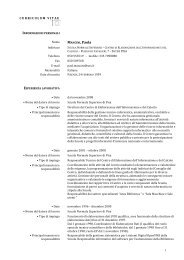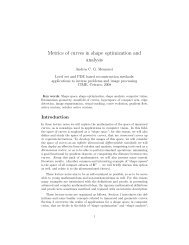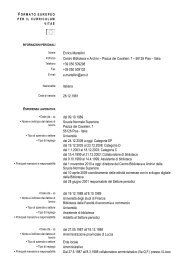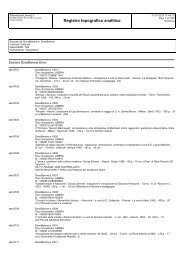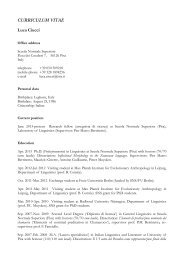QUADERNI DEL LABORATORIO DI LINGUISTICA – VOL. 9,2/2010different semantic properties, may fill in <strong>the</strong> PPF slot. 3 To <strong>the</strong> extent, however, that <strong>the</strong>above statement is true, it is in striking contrast with <strong>the</strong> situation to be found withano<strong>the</strong>r member <strong>of</strong> <strong>the</strong> perfect-tenses set, namely <strong>the</strong> Present Perfect, characterized byconsiderable diachronic instability, namely by its cross-linguistic tendency to shiftfrom <strong>the</strong> domain <strong>of</strong> <strong>the</strong> perfect into <strong>the</strong> domain <strong>of</strong> pure perfectivity, or “aoristicity”.Assuming <strong>the</strong> given background, this paper will address a somehow deviant usage<strong>of</strong> <strong>the</strong> PPF in Italian and (tentatively) German. The examples are taken from literarytexts, for <strong>the</strong>y <strong>of</strong>fer a better illustration <strong>of</strong> <strong>the</strong> issue, but this should not be interpretedas entailing that <strong>the</strong> phenomenon at hand does not emerge in <strong>the</strong> colloquial registers.The temporal architecture <strong>of</strong> all narrative texts – including <strong>the</strong> oral ones – rests on<strong>the</strong> so-called “propulsive” tenses, <strong>the</strong> ones that have <strong>the</strong> capacity <strong>of</strong> pushing forward,so to say, <strong>the</strong> thread-<strong>of</strong>-discourse. In literary narrative texts, in particular, <strong>the</strong>propulsive function is standardly – i.e., traditionally – assigned to aoristic pasts (cf. <strong>the</strong>Fr. Passé Simple or <strong>the</strong> It. Passato Semplice, traditionally called Passato Remoto), orat least tenses that may take on this interpretation although this is not <strong>the</strong>ir onlyreading (cf. <strong>the</strong> Eng. Simple Past). Occasionally, <strong>the</strong> propulsive function may betransferred to o<strong>the</strong>r tenses, like <strong>the</strong> “narrative” Present in <strong>the</strong> European literarytradition. In oral narratives, <strong>the</strong> use <strong>of</strong> <strong>the</strong> Present as a propulsive tense, in alternationwith <strong>the</strong> perfective Past(s), is fairly frequent. Depending on <strong>the</strong> degree <strong>of</strong> involvement<strong>of</strong> <strong>the</strong> speaker, o<strong>the</strong>r possibilities may emerge, such as <strong>the</strong> alternation <strong>of</strong> Simple vs.Compound Past in Romance. 4 Interestingly, many languages – most notably among______________________________________________________________________This expansion into <strong>the</strong> domain <strong>of</strong> modality is obviously less viable, e.g., in Italian (where it isrestricted to stylistically substandard usages) due to <strong>the</strong> division <strong>of</strong> labor between Indicative andSubjunctive PPF. Needless to say, <strong>the</strong> existence <strong>of</strong> PPF tenses in different moods is a highly interestingtopic, which however this paper does not address. To <strong>the</strong> extent that Subjunctive <strong>Pluperfect</strong>s will showup in <strong>the</strong> examples presented below, <strong>the</strong> analysis will be restricted to <strong>the</strong>ir temporal-aspectual meaning,while <strong>the</strong>ir modality component will not be discussed.3A case in point is Italian, with two <strong>Pluperfect</strong>s in <strong>the</strong> indicative mood (apart from <strong>the</strong> SubjunctivePPF), traditionally called Trapassato Prossimo and Trapassato Remoto (Piucheperfetto and Trapassato inBertinetto 1986). The examples to be discussed in this paper are however limited to <strong>the</strong> most frequent(and semantically unconstrained) alternative, namely <strong>the</strong> PPF (Piucheperfetto). For a discussion <strong>of</strong> <strong>the</strong>structural differences between <strong>the</strong>se two forms, see Bertinetto (1987).4The use <strong>of</strong> <strong>the</strong> “narrative” Present in English oral narratives, and its strategic alternation with <strong>the</strong>Simple Past, has been extensively studied at least since Wolfson (1979), Schiffrin (1981) and Silva-Corvalán (1983). As for <strong>the</strong> alternation between Simple vs. Compound Past, <strong>the</strong> issue was dealt with at2
QUADERNI DEL LABORATORIO DI LINGUISTICA – VOL. 9,2/2010those spoken in Africa – even dispose <strong>of</strong> a specific (set <strong>of</strong>) “narrative” tense(s), onlyto be used in this type <strong>of</strong> texts, traditionally produced in oral form. Apparently, this isnot <strong>the</strong> case in <strong>the</strong> European languages, where <strong>the</strong> typically propulsive tenses have, toa lesser <strong>of</strong> larger extent, a wider usage potential. However, on close inspection it turnsout that something <strong>of</strong> <strong>the</strong> sort may be detected even in <strong>the</strong> European literary tradition.Indeed, in literary narratives <strong>the</strong> propulsive function is fulfilled by tenses which,although far from unmarked in general, should be regarded as unmarked precisely insuch contexts. The reason for this is straightforward, as noted by Fludernik (1993).The tense-aspect system underlying oral linguistic productions is anchored on <strong>the</strong>Speech Time, acting as <strong>the</strong> deictic pole <strong>of</strong> attraction. Thus, <strong>the</strong> Present is <strong>the</strong> unmarkedtense in normal situations. In literary texts, by contrast, an imaginary “Speech Time”is <strong>conv<strong>entional</strong></strong>ly adopted, ostensibly distinct from <strong>the</strong> hic et nunc <strong>of</strong> <strong>the</strong> act <strong>of</strong> writingand assumed to be localized in a fictional past, even when <strong>the</strong> author describes a futureworld (as is typical <strong>of</strong> science-fiction narratives). This fictional anchoring time,implicitly shared by <strong>the</strong> reader, produces a thorough reorientation <strong>of</strong> <strong>the</strong> time-axis, to<strong>the</strong> effect that <strong>the</strong> propulsive Past becomes, in such contexts, <strong>the</strong> unmarked tensearound which <strong>the</strong> whole system recalibrates itself.In recent times, several attempts have been made in different literary environmentsto renew <strong>the</strong> narrative strategies, by promoting to propulsive function tenses that weretraditionally alien to it. The present author has demonstrated this with examples drawnfrom <strong>the</strong> Italian literature <strong>of</strong> <strong>the</strong> past few decades (Bertinetto 2001; 2003, ch. 2). One<strong>of</strong> <strong>the</strong> devices exploited to this effect is <strong>the</strong> use <strong>of</strong> <strong>the</strong> PPF as an alternative to <strong>the</strong>Simple Past. This study extends <strong>the</strong> analysis with fur<strong>the</strong>r examples.2 Anteriority <strong>Pluperfect</strong> vs. aoristic <strong>Pluperfect</strong>Assuming Reichenbach’s (1947) classical proposal, <strong>the</strong> semantic representation <strong>of</strong><strong>the</strong> PPF’s protopypical <strong>uses</strong> may be symbolized as in <strong>the</strong> following diagram. Thelocalization <strong>of</strong> R can be explicit or implicit, as shown in [1]:______________________________________________________________________length in Weinrich’s (1964) seminal work, although <strong>the</strong> conclusions arrived at appear to be ra<strong>the</strong>raprioristic according to <strong>the</strong> present author.3



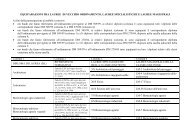
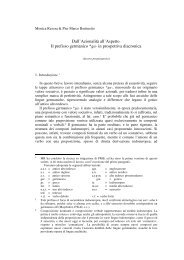
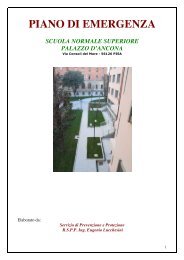
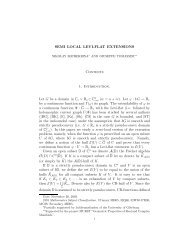
![4. Ghost [Å] vowels in French - Laboratorio di Linguistica](https://img.yumpu.com/49999334/1/184x260/4-ghost-a-vowels-in-french-laboratorio-di-linguistica.jpg?quality=85)



